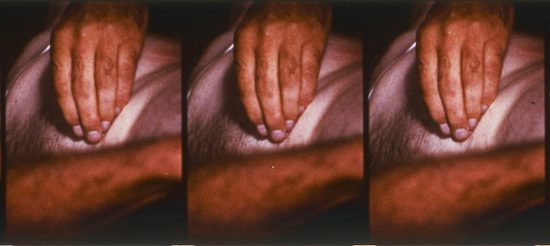The Act of Seeing With One’s Own Eyes is a project curated by the British artist Ed Atkins that features two linked works shown in separate spaces. The title is taken from a notorious 1971 film by Stan Brakhage that can be seen downstairs in the gloom of a basement Keller. There’s a notice warning about the explicit contents before you push at the smoked glass doors.
Brakhage was a highly regarded experimental filmmaker, the creator of abstract imagery sometimes featuring blotches and scratches on celluloid that one might associate accompanying psychedelic music. This grainy 16mm film though is very different. What we see is a group of Pittsburgh pathologists at work in a mortuary. The film is also silent and lasts an intense thirty-two minutes. Cadavers are seen on gurneys, some covered in white sheets; others lie prone on steel tables. There is much blood and there are brains cupped in live hands as they slip out from open skulls. Sad dead feet flop about unintentionally as a body is manipulated more cranially out of shot. The film is not a pedagogic work for medical students. Brakhage’s film is art in the same sense that Rembrandt’s painting The Anatomy Lesson of Dr. Nicolaes Tulp (1632) was art; these works make us think about that frail thing we all are: a body.
Watching the various corpses being dissected – the heads being incised, the voids of the abdominal cavities exposed and then flushed out, the organs weighed and measured – gives rise to many questions about the nature of observation. We might break such enquiry down to the reactions of four interested parties: firstly and predominantly there is our own response; then there is that of our peers here – the other members of the audience; thirdly that of Brakhage himself; finally the crucial intentions of Atkins as curator.
A caveat: I’ve been here before, for real, having attended post-mortems. The medical gaze (that of doctors and pathologists) is predominantly that of the distanced scientist who asks coldly: what has happened here? What is/are the cause(s) of death? For a medic there is a degree of frustration watching Brakhage’s film in the sense that we want to know more about the aetiology of the demise. We see a thumb imprint itself in the oedema of an ankle and assume cardiac failure as contributory. There are what appear to be dialysis lines in another cadaver. Other bodies intrigue with the possibility of murder, assault and criminal involvement. But Brakhage deliberately excludes us from making swift and facile conclusions with his deliberate fast editing, his own fearless cutting; this film was not meant to be easily explicated.
Some visitors will fear the imagery of dissection but doctors are scared of pathologists themselves. They dread the phone call that asks that they come down to the morgue where they will be confronted with the stark reality of a mis-diagnosis, the incorrect interpretation of an X-ray, the operation gone wrong.
The overwhelming silence of the film was mirrored, when I attended, by a stunned audience. Scanning the pallid faces as people left the room I saw horrified Japanese women lifting hands to their faces, German hipsters affecting a phony sangfroid – a contrived ‘seen it all before’ pose, some academics trying to preserve their cool. There was an air of bravado too for others, as with school kids on their first visit to an anatomy museum. A few were here deliberately to see the transgressive – shock me! – here to stare at what they have never seen before, to look at Brakhage’s imagery with a prurient, voyeuristic intent, as if glimpsing pornography for the first time.
And indeed Brakhage does not spare us. The handling of the bodies appears rough, insensitive. We see a huge syringe draining what might be an effusion on the lung, other internal cavities being sluiced like meat at an abattoir, reproductive organs are deprived, exposed brutally, muted of all erotic association. This is what being dead looks like and it’s for real.
So much for the visions. What about the other sensory modalities that accompany autopsies? Upstairs, in sharp contrast, is the bright white light of an octagonal pavilion quite empty of imagery and a sound piece by David Kamp. Like a Foley artist he gives us the noise of water washing and scrubbing, the metallic clunk of trolleys on the move, the frighteningly comic buzz of a saw as it cuts bone. Of course deprived of context this horrific noise might just sound like a lawnmower, the ambient sounds of another world – rustic, bosky.
Another key sensory dimension is missing though: smell. Post-mortems can make people gag for a number of reasons but surely the aroma ranks very high as an emetic stimulus – the reek of faeces and urine mingling with the tang of formalin and phenol. Quite disgusting.
What of Brakhage’s intentions? He is interested in the day-to-day business of how pathologists work – this is what he shows us here, how our beloved bodies are reduced to a mere object for study. And those of Atkins? By showing these two works in separate spaces the curator is exploring several issues. He’s interested in how we willfully try and tame the unbearable, the horrific final state of our form, the true fate of the body, by denuding our senses of key information. There is no instruction as to which part of the show to see first. Atkins would have us try it both ways.
A line from John le Carré’s Smiley’s People (1979) might sum up Atkins’ message here. Spymaster George Smiley has just witnessed a corpse with its face blown off, his political master Lacon is sympathetic:
“Was it gruesome, George? How perfectly awful for you.”
No, it wasn’t awful, it was the truth, thought Smiley.
The Act of Seeing With One’s Own Eyes is at the Schinkel Pavilion, Berlin, until 24 March 2019


